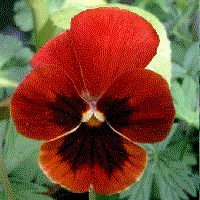 |
VIOLACEAE - The Violet Family
This is a family of about 900 species, mainly of temperate regions, where they are usually small perennial plants of the Viola type, and herbs, shrubs and trees from tropical regions whose flowers are significantly different from the familiar violet. As the Violas and Pansies (Viola x wittrockiana hybrids) are those most usually encountered by gardeners, the information here refers only to these members of the family. |
Characteristics of this Plant Family:
Leaves, Stem & Roots ~ The leaves are often heart shaped, sometimes toothed, or they may be finely cut. In some alpine species (Rosulate Violas), the leaves are almost succulent and round and form a dense ball or cushion, often looking more like a cactus or a pine cone than a violet, but these are not often seen.
Flowers ~ The flowers arise singly on long stems from the leaf axils. They have five petals of unequal size, with the lower ones forming a spur at the back of the flower which contains nectar. There are honey guidelines directing insects into the spur to pollinate the flower. Wild violets and violas are often blue, white, purple (violet) and yellow, but larger hybrids have been bred in all colours.
Seeds ~ The seed capsule has three parts fused to form one chamber. In some species, this is pointed and triangular, and in others it is rounded. Species may sometimes be identified by the shape and colour of the seed pod. The seeds are dispersed when the capsule splits into three, forming a three-pointed 'star'. Seeds are yellow or brown and rounded.
Many members of this family produce incomplete flowers on short stems after the main flowering period. These do not open properly and are self-pollinating; they are called cleistogamous flowers, and they set viable seed.
Members of this Family usually have:
Alternate leaves with small leafy growths
Flowers like violets with five unequal petals and a spur
Calyx of five parts
Three part seed capsule
and may have cleistogamous flowers